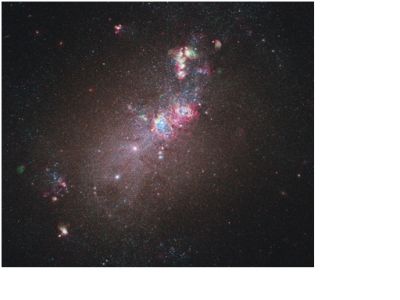
A Hubble Space Telescope image of the dwarf galaxy NGC 4214
Credit: NASA, ESA, and the Hubble Heritage (STScI/AURA)-ESA/Hubble Collaboration
NASA recently published an image of a beautiful small galaxy, technically designated NGC 4214. The image was acquired by the Hubble Space Telescope (HST), a sophisticated space-based observatory, exploring the universe form Earth orbit. The image shows that NGC 4214 is an active galaxy, in which new stars are being born, out of vast colorful clouds of gas and cosmic dust.
Hubble’s image reveals a sequence of stages of formation and evolution of stars and star clusters. (Star clusters are gravitationally-bound agglomerations of stars.) The clusters of newly born stars appear within bright clouds of glowing gas. The emission of the clouds is induced by strong ultraviolet radiation, emitted by hot young stars, hidden within the clouds. These stars also eject streams of particles, termed "stellar winds", flowing into the surrounding gas, at enormous speeds of millions of kilometers per hour. The radiation and stellar winds from these stars literally produce bubbles in the gas.
The dominant object near the center of NGC 4214 is a rich cluster of hundreds of massive blue stars, each more than 10,000 times brighter than the Sun. A large heart-shaped bubble, blown by the stellar winds and radiation, envelopes the cluster. This bubble will expand, as the most massive stars in the center reach the ends of their evolution, and explode as supernovae. (Giant exploding stars are termed supernovae.)
Unlike our Galaxy, the Milky Way, which is spiral in shape, NGC 4214 belongs to a category of small galaxies, known as irregular galaxies, as they have no regular shape. This dwarf galaxy is located 10 million light-years away. (The light year is a unit of measuring astronomical distances, and is approximately 10,000 billion km.) By the standards of cosmic distances, NGC 4214 is very close to our Galaxy. The HST images of NGC 4214 were acquired in December 2009, applying the Wide Field Camera 3 instrument, in visual light and ultraviolet.
References
The Hubble Site
http://huublesite.org/